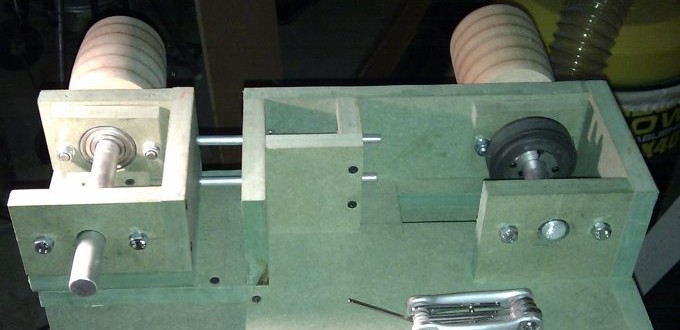As part of my belt sander build it is necessary to do a little maths to determine the best size for the belt rollers to give an appropriate length of flat sanding area and belt speed. The first thing to do is to determine the desired belt speed. I looked up the belt speeds of a number of commercial designs and I was really surprised by range, the difference between the slowest and fastest was about 100% so I picked a number about half way between the extremes at 450m/min. Most people agreed that wood removal rate had more to do with the correct choice of grit than belt speed so I think this is a fair speed to choose.
Given the linear belt speed I now need to determine the revolutions/minute of my drive wheel. This requires the diameter of the drive wheel which I’m currently planning to make 10cm. The equation linking linear velocity and angular velocity is:
v = rω Equation 1
where v is the linear velocity in meters/minute, r is the radius in meters and ω is the angular velocity in radians/second. A formula containing the angular velocity isn’t much use since that is never quoted for motors but RPM is and it is related to angular velocity by this equation:
ω = 2πρ Equation 2
where ρ is the revolutions per second of the drive wheel. Substituting equation 2 into equation 1 and rearranging so we can find ρ gives us:
v / 2πr = ρ Equation 3
Since we know the linear velocity we desire and we have set the radius of the drive wheel we can now calculate the required RPM of the drive wheel. Before we do that though it’s worth stating that units are important, the belt speed is easiest to measure in m/min but the diameter of the drive wheel is 10 cm or 100mm. All the lengths have to be expressed in the same unit so convert the diameter from 10cm to 0.1m. This gives:
450 / 3.14 * 0.1 = 1432
which tells us the desired RPM is 1432. Note that we replaced the 2r in the equation with the diameter to save dividing it by 2 only to multiply it by two again!
So, we need a drive wheel that is 10cm in diameter and spinning at 1432 RPM. That should be fairly easy to achieve as a 4 pole motor running on 50Hz happens to rotate at almost exactly that speed so the pulley on the motor and the pulley on the drive shaft simply have to be the same size.
